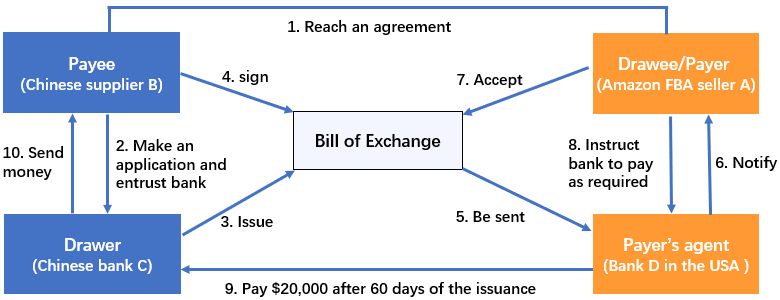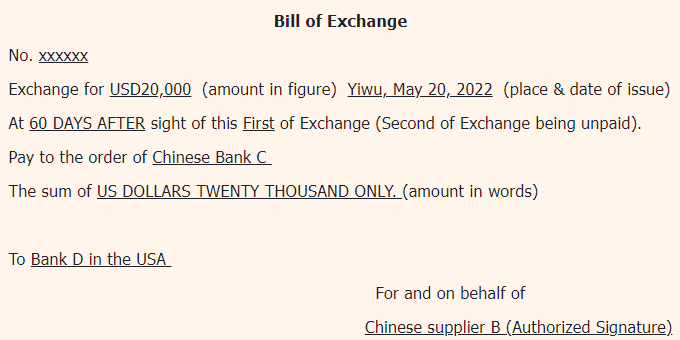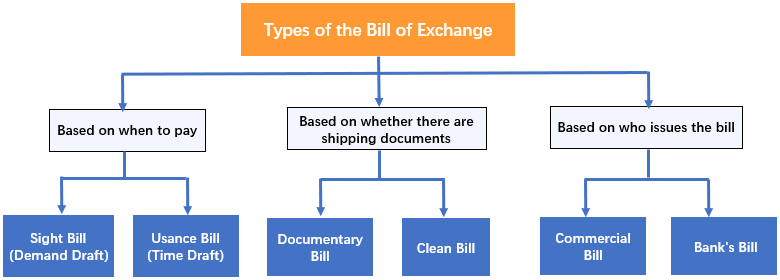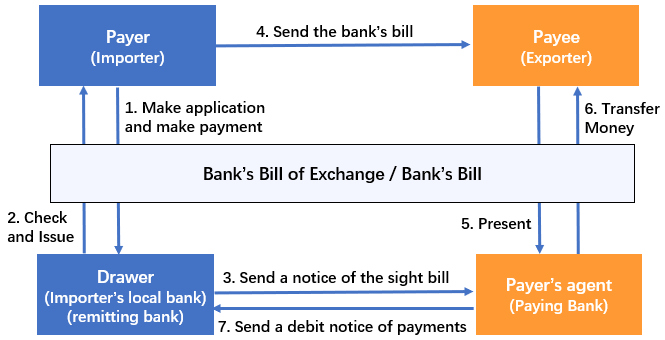Among a series of export and import documents, you must hear about the bill of exchange, B/E. It is a credit instrument with broad application in international settlement. To help you better understand B/E, I write today’s article to explain what it is and the common 6 types.
You can navigate to related content via the below links.
What is B/E, Bill of Exchange?
Bill of exchange, B/E, BoE, or draft, is essentially a deferred payment voucher built on credit. It is often used in international business, which requires buyers to pay for orders on a future payable date as negotiated with the supplier.
For instance, Amazon FBA seller A in the USA buys socks from a Chinese supplier called B in Yiwu, with an order value of $20,000, and promises to pay in 60 days. The supplier entrusts the Chinese bank C to issue a bill of exchange. It clearly states that A shall pay B $20,000 after 60 days of the issuance (May 20, 2022). The Amazon seller accepts the bill and authorizes his bank D to send money on the appointed date.
For importers, the bill of exchange acts as their credit voucher for future payments, without the need to pay immediately. This is the biggest benefit of B/E. For exporters, they can use it as the payment notice, requiring buyers to send money as promised.
Typically, the bill of exchange is a written document with 3 key features as follows.
Feature 1: Three parties involved in
Drawer — The one who issues the bill and signs it. Oftentimes, it is drawn by the seller (exporter) or designated bank.
Drawee/Payer — The person who makes payments. Usually, it is the buyer (importer) or designated bank.
Payee — The person who receives payments, that is, the seller or the seller’s bank. Usually, the payee is the drawer.
Feature 2: Unconditional order to pay
The payer must transfer a specified sum of money on an appointed day as written in the bill. No additional payment requirements.
Feature 3: Negotiable instrument
You can exchange the B/E for money. Also, you can transfer it to another person through endorsement, and the bill holder can take it to draw money.
Still using the above example, the bill of exchange works in the following way.
Click to Enlarge
Basic info included in B/E and format
The bill of exchange is made in proper form. Although the bill of exchange might look different, you’ll find a series of key info on any bill of exchange.
Still use the above example. Here the bill of exchange would be as follows.
Bill of Exchange Format
Click to Enlarge
As you can see, the B/E uses the imperative sentence to order the payer to send money. Also, there are some essential points written in the draft.
7 essentials of the bill of exchange
1. Bill No. (generally invoice NO.) and Date of issue (after the contract date).
2. Payer: importers or importer’s bank. If it is the bank, attach the address.
3. Payee/Receiver: exporters or exporter’s bank. Usually followed by “pay to the order of xxx”.
4. Specify the currency code and sum of money (the same as the invoice amount). If there is an interest clause, specify the interest rate. That is, “Payable with interest @ xxx%”.
5. Specify the date to pay.
- If paid at sight, just type in “at sight”. If it already exists, just mark “–” on the horizontal line between “At” and “sight”.
- If paid xxx days after sight, it will be “At xx Days after Sight”.
6. State the first or second exchange. Generally, B/E is issued in duplicate to prevent losses caused by the issue of being lost when sent. Both have the same legal effect. One bill is paid, and the other one will automatically become invalid.
7. Write the exporter’s information in the bottom right corner, with a signature or seal.
If under the L/C payment term, the above information should be in line with that of L/C. Besides, it should also make the following points clear:
- Drawn under the name of opening bank/issuing bank.
- L/C No.; Dated (L/C issuing date); No. (can’t be earlier than the B/L date).
- State whether to endorse or not.
It will look like this.
Click to Enlarge
One more thing, if part of the order payment is under collections (D/A and D/P) and the balance is under L/C, there will be 2 bills of exchange. Write the payment amount as required and ensure the sum is equal to the invoice amount.
6 Common B/E Types and Use
There are many types of bills of exchange. In practice, it is common to see the following 6 types, as shown in the image. Here I’ll explain them one by one, with the focus on what it is and what to look out for when using it.
Clean Bill and Documentary Bill
Clean bills are sent without any shipping documents such as the B/L and packing list. In global trade, it is usually used to collect or pay freights, balance payments, commissions, etc.
A documentary bill is sent alongside shipping documents. It is more often used than the cleaning bill in international trade. For example, you’ll see a documentary bill under D/A, D/P, and L/C. Before getting the B/L to pick up goods, importers need to make:
- Acceptance of the documentary bill, if under D/A.
- Payments when seeing the documentary bill, if under D/P after Sight.
- Acceptance of the documentary bill and finish payments, if under D/P after Sight.
If part of the order payment is under L/C and the balance is under collections (usually D/P), there will be 2 bills of exchange, and the full set of shipping documents should be sent together with the latter one.
Sight Bill / Demand Draft
The sight bill is payable directly upon the presentation. As the payer, you should transfer money once receiving the draft.
- If under L/C at sight, your bank finishes payments upon receiving the demand draft.
- If under the D/P at sight, your bank receives the demand draft and notifies you of payments at once.
Generally speaking, a sight bill must be a documentary bill. Once you pay, you’ll get shipping documents and own the title to the transported goods. Sight bills are a preferred option for suppliers, as they can keep the title to the goods before receiving the order payment.
Usance Bill / Time Draft
Unlike the sight bill, there is a short-term delay in payment when receiving a time draft or usance bill. With regard to the payment date, it is common to see the following 4 ways.
- At xxx days after sight. It is common to see 30 days, 45 days, and 60 days.
- At xxx days after the B/L date.
- At xxx days after the date of issuance.
- On a fixed future date, such as “On July 20, 2022“.
If using the latter three, cross out the “sight” printed on the bill.
In actual business, buyers and suppliers negotiate about how to calculate the payment date and make that clear in the contract and bill of exchange.
Principles for the calculation of “At xxx days after xxx”.
Generally, the calculation starts with the next day of the mentioned date. The last day of xxx days shall be the due date, which shall be postponed in case of weekends or holidays.
Take “At D/P 90 days after sight” for example. Suppose the acceptance date is April 17, 2022.
- The starting date is April 18, 2022.
- The bill’s due date is July 16, 2022, which happens to be Saturday.
- So, the due date is postponed to July 18, 2022.
Note: you’d better avoid the use of “from” on the bill, such as “At 90 days from 15th April”. As it means the calculation starts on April 15, and the maturity date shall be July 15.
Obviously, the sight bill is beneficial for importers, as they can pay until the appointed future time and ease their cash flow pressures.
JingSourcing supports your business with a good, flexible time limit for order payments.
Additionally, the time draft has the following 2 features.
Time Draft Feature 1 — require the act of “acceptance”.
If it is accepted by the bank, it is safe for suppliers. Because the bank guarantees the payment, even if the importer fails to pay. This type of B/E is also called a bank’s acceptance bill.
Time Draft Feature 1 — allow the discounting of B/E to get money in advance.
If the receiver (exporter) is in urgent need of cash, but the bill is not yet due. At this point, he can sell the bill to the bank to obtain funds. This is the discounting of bills of exchange.
Moreover, there is a discount rate, as the bank gives you the money ahead of the due date. Oftentimes, the bank will charge interest: the bill value * discount rate.
Commercial Bill and Bank Bill with Example
Commercial Bill means enterprises issue the draft. It is common to see this bill type under the collection and L/C payment terms, whereby the exporter issue the bill as the drawer.
When the draft is drawn under banks, it is called “Bank’s Bill of Exchange”. When using the international payment method D/D (one type of remittance), there will be a bank bill of exchange.
Suppose you are importing toys from China and negotiate with your supplier to pay under D/D. Let’s look at how a bank’s bill works.
Step 1:
You should go to the local bank (the remitting bank) to
- Check your bank account.
- Confirm the money in the account.
- Apply to the bank for the making of a bill, which orders the Paying bank to transfer funds to your Chinese supplier.
Typically, the banker will check all information and charge service fees.
Step 2:
The remitting bank will send a notice of the sight bill to the Paying bank. You send the bank’s bill to your supplier.
Step 3:
Your Chinese supplier presents the bill to the Paying bank and draws money. After that, the paying bank will send a debit notice of payments to the remitting bank for payment.
Click to Enlarge
Last but not least, a bank bill is a sight bill and there is often no “acceptance” required.
The End
If this article helps you better know the B/E, you can share it with your friends. Or if you have further questions about the use of a certain B/E type for your importation, leave your comment below. We’ll help you solve it.
As a leading sourcing agent in China, Jingsourcing has helped many clients import products at competitive prices, with good and flexible payment terms. Besides product sourcing and shipping service, we also offer quality inspection, private label, Amazon FBA solutions, etc. If you need any support, feel free to contact us.





